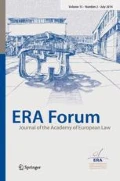Abstract
In the context of European Union standards, our understanding of victims’ protection has to be redefined. Unconditional support for trafficked persons is manifested in EU Directive 2011/36/EU. Yet, both the right to and access to psycho-social counselling, to residence permits and to compensation is hindered through an inconsistent international legal framework. Victims’ rights have to be at the centre of victims’ protection, with a focus on their individual vulnerabilities and needs. Therefore this paper argues that victims’ protection of trafficked persons has to be understood in a broader safety frame.
Similar content being viewed by others
Notes
Directive 2011/36/EU of the European Parliament and of the Council of 5 April 2011 on preventing and combating trafficking in human beings and protecting its victims, and replacing Council Framework Decision 2002/629/JHA [2011] OJ L 101/1.
Directive 2012/29/EU of the European Parliament and of the Council of 25 October 2012 establishing minimum standards on the rights, support and protection of victims of crime, and replacing Council Framework Decision 2001/220/JHA [2012] OJ L 315/57.
Council Directive 2004/80/EC of 29 April 2004 relating to compensation to crime victims [2004] OJ L 26/15.
Council Directive 2004/81/EC of 29 April 2004 on the residence permit issued to third-country nationals who are victims of trafficking in human beings or who have been the subject of an action to facilitate illegal immigration, who cooperate with the competent authorities [2004] OJ L 261/19.
Directive 2012/29/EU of the European Parliament and of the Council of 25 October 2012 establishing minimum standards on the rights, support and protection of victims of crime, and replacing Council Framework Decision 2001/220/JHA [2012] OJ L 315/57.
Art. 57 Austrian Asylum Act.
Brunovskis/ Skilbrei [1], p. 14.
Art. 6 and Art. 11 of Directive 2011/36/EU of the European Parliament and of the Council of 5 April 2011 on preventing and combating trafficking in human beings and protecting its victims, and replacing Council Framework Decision 2002/629/JHA [2011] OJ L 101/1.
Council Directive 2004/81/EC of 29 April 2004 on the residence permit issued to third-country nationals who are victims of trafficking in human beings or who have been the subject of an action to facilitate illegal immigration, who cooperate with the competent authorities [2004] OJ L 261/19.
Brunovskis/ Skilbrei [1], p. 18.
Planitzer et al. [2]. This study was conducted in the framework of COMP.ACT (European Action for Compensation for Trafficked Persons) with financial support from the Prevention of and Fight against Crime Programme European Commission—Directorate-General Justice, Freedom and Security. The project Justice at Last will further explore obstacles for claiming compensation, partly funded by the European Union’s Justice Program (2014–2020). The project is coordinated by La Strada International and implemented in cooperation with partners in Bulgaria (Animus Association), Czech Republic (La Strada), Spain (SicarCAT and Esperanza), Germany (KOK), Austria (LEFO), The Netherlands (FairWork), Ireland (MRCI), Romania (Adpare), Macedonia (Open Gate/La Strada) and Serbia (ASTRA). Through studies in the framework of Justice at Last findings on compensation are expected.
Cf. ibid.
Scherr [3], p. 156.
Regulation (EU) No 604/2013 of the European Parliamant and of the Council of 26 June 2013 establishing the criteria and mechanisms for determining the Member State responsible for examining an application for international protection lodged in one of the Member States by a third country national or a stateless person (recast) [2013] OJ L 180/31.
Art. 17 of Directive 2011/36/EU.
Planitzer et al. [2].
References
Brunkowski, A.M.L.: Two birds with one stone? Implications of conditional assistance in victim protection and prosecution of traffickers. In: Anti Trafficking Review, vol. 6, pp. 13–30 (2016)
Planitzer, J., et al.: Entschädigung für Betroffene des Menschenhandels. ÖGB Verlag, Wien (2011)
Scherr, A.: Wer soll deportiert werden? Wie die folgenreiche Unterscheidung zwischen den “wirklichen” Flüchtlingen, den zu Duldenden und den Abschiebenden hergestellt wird. Springer, Wiesbaden (2015)
Author information
Authors and Affiliations
Corresponding author
Rights and permissions
About this article
Cite this article
Probst, E. Victims’ protection within the context of trafficking in human beings and European Union standards. ERA Forum 19, 357–367 (2019). https://doi.org/10.1007/s12027-018-0526-3
Published:
Issue Date:
DOI: https://doi.org/10.1007/s12027-018-0526-3




